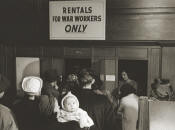It was a big war, and to win it, a lot of supplies had to be made fast. Manufacturers were contracted. New factories were built. People were hired. Good jobs were created everywhere, and nearly eight million people flocked from all over the country to fill them.
 Most of the migrants ended up in war towns, instant communities that sprouted up near manufacturing facilities that had just sprouted up themselves as the federal government delivered piles of money to build war supplies. A total of $240 billion went to aircraft manufacturers on the West Coast, to shipyards on both coasts, to arms makers in New England, and to various other industries and regions. Detroit automakers raked in a fortune to turn out military vehicles. Chrysler built the largest factory in the world.
Most of the migrants ended up in war towns, instant communities that sprouted up near manufacturing facilities that had just sprouted up themselves as the federal government delivered piles of money to build war supplies. A total of $240 billion went to aircraft manufacturers on the West Coast, to shipyards on both coasts, to arms makers in New England, and to various other industries and regions. Detroit automakers raked in a fortune to turn out military vehicles. Chrysler built the largest factory in the world.
The towns were generally outside existing cities, on what had recently been open fields. At the start, they were often nothing more than tent camps or trailer parks filled with rural folk who’d come to make lots of money overnight. And that they did, more than they’d ever made in their lives. But the living conditions they endured while they made their would-be fortunes were harsh.
The makeshift towns of shacks, tents, and trailers were dubbed New Hoover-villes, after the camps of homeless that had appeared early in the Great Depression while Herbert Hoover was president. Some migrant war workers slept in churches; others settled for the streets. Rental units were hard to find. It was a sellers’ market, and despite attempts by the federal Office of Price Administration to control rents, landlords generally got away with gouging. As many as five people shared a bed, sleeping in shifts, and 35 people shared a single toilet. Even sheds, chicken coops, and barns were expensive accommodations.
The federal government tried to alleviate the housing shortage by building its own projects and lending money to private companies to do the same. Congress passed the Lanham Act, which eventually funded $7 billion of barracks, trailer grounds, mobile homes, dorms, housing projects, and other types of shelter. At best, federal housing provided for 7 million of the 9 million people who needed housing. Living conditions in the new shelters ranged from good to despicable. In one unit at the project at Lay Garden, Michigan, there were five people living on the first floor, five in the basement, four on the second floor, nine in the garage, and four families in the back yard in trailers.
The war towns had more than their share of problems, and the newcomers had little political clout for getting them solved. They were nonvoting, nonhomeowning, and nontaxpaying, so no one listened when they complained about inadequate police protection, overcrowded schools, inadequate sewage, and pot-holed roads. On top of that, locals were prejudiced against them, with their different skin color, perhaps, their rural dialects, and their foreign lifestyles. Locals had no trouble rationalizing that the migrants didn’t deserve help. In Mobile, Alabama, the region that grew most during the war and, consequently, the home of the nation’s worst schools, one teacher commented, “Give them a good home and they wouldn’t know what to do with it….” There was truth in that cold observation. The migrants tended to be independent-minded farmers, hillbillies, and backwoodsmen who kept to themselves and did things their own way. A lot of them preferred tents and shacks to anything that might come from the government with strings attached.
The Mobile teacher touched on another migrant problem, too: “I only hope we can get rid of them after the war.” People throughout the country shared that sentiment. Even the government purposely built its projects so they would not last and the migrants would not be able to stay permanently. First Lady Eleanor Roosevelt had hoped to use federal money to renovate previously existing housing projects, which were inhabited mostly by black people. Opposition was strong, however, and language was added to the Lanham Act expressly to forbid such funding.
After the war ended, some five million Americans needed homes. As servicemen returned from overseas, the government gave units in housing projects it had built during the war to tens of thousands of them. It would take years to make up for the wartime shortage of residential construction, but the country would soon see a housing boom unprecedented in the history of the world.
Copyright 310 Publishing, LLC. All rights reserved.



FOLLOW US »
